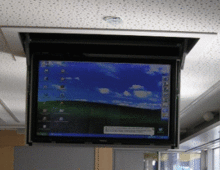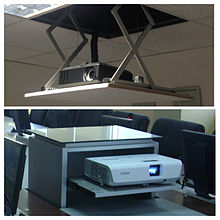TV lift
A Television-lift , short TV lift , TV lift or TV lifting system called, is a plant, can be electrically driven out with the help of television sets in vertical or horizontal direction from furniture, ceilings or partitions. The main reason for using a TV lift system is to integrate a television into the existing room design without the television interfering with it. TV lifts are considered to be a luxury product in accordance with the high overall project costs associated with them and are therefore mainly found in apartments of higher standards, conference rooms, private jets or yachts.
history
The first TV lifts hit the US market in the early 1950s. Due to the tube televisions of that time, these were mostly very large, clunky structures that required a lot of installation space. In the beginning there were mainly TV lifts that lifted the tube TV vertically out of a piece of furniture or a room divider. Vertical ceiling lifts did not come into use until the mid-1970s, as the television industry was producing tube televisions that were flatter and lighter during this period. At the beginning of 2000, with the introduction of plasma screens , less clunky systems came onto the market, for example under the brand name Flatlift . After the lighter LED televisions replaced the plasma flat screen technology in 2011, the technology could be simplified again.
Types and forms of TV lift devices
The following systems usually have in common that the television is usually mounted on or in them using the Vesa mounting standard. There are adapters for different standards. Furthermore, a combination of the following devices with different lid flap solutions is feasible as a special construction in most cases. With some manufacturers, the extension speed and end position of the television can be programmed.
Pop-up
TV lift systems are available in a wide variety of designs. The most commonly used design in the vertical process is a multi-part tube that, driven by internal spindles and electric motors, moves upwards when pushed apart. The TV then changes its position by moving the individual tubes apart. The upright tube, which usually runs in the middle, is equipped with a base on the floor, which ensures stable attachment in the installation object.
Depending on the manufacturer, there is also the U construction for vertical TV lift applications. In this case, a platform drives the television upwards out of the furniture via a tubular motor. This construction is now considered obsolete.
Pop-down
In the case of the vertically lowerable TV ceiling lift systems that function in reverse, the design is visually similar to that of the lifting systems, but components are used that are designed for tensile loads. These are far more expensive than components for pressure application because they have to absorb greater holding forces.
The cover solution is implemented congruently to the pop-up TV lift systems, only in the opposite direction.
Ceiling lift
With this type of TV lift, the TV is with the display facing up in the false ceiling and is not visible from below from the room, as it is completely integrated in the false ceiling. If the user operates the remote control, the television folds down by 90 ° or more. With some ceiling lift systems, the device can also be lowered by a certain height or rotated in the middle of the room.
The structure usually consists of an aluminum frame, on the inside of which two motors are attached, which hold an inner flap with the television and can swing it downwards. There are also models made from a box made of powder-coated steel. A gear motor is flanged to the side and outside of the flap, which then moves the flap with the TV set via a shaft.
Lift system with side extension
Laterally extendable TV lifts are usually installed in furniture cabinets or partition walls. Using one or more rails and drives, it is possible to extend the TV sideways out of the furniture or the wall. Some manufacturers also manufacture a twist in the extended state in a special design. The TV can slide out of the side of the cabinet and then be swiveled in one direction in the room, which enables a free choice of seating arrangement and direction.
Monitor lift
The structure of a monitor lift system is largely similar to that of the vertical pop-up TV lift system, except that the motorized and electrical components are built into a sheet metal module. The system is intended for smaller PC monitor sizes. They are mainly installed in conference tables to save space. The monitor lift systems are let into a table cutout from above, which is made by a carpenter or carpenter, and are fixed to the table again from below using screws. The upper part of the monitor lift system is often a cover plate made of brushed stainless steel. At the push of a button, a cover cut-out folds inwards into the monitor lift, clearing the way for the monitor. This extends automatically upwards and can still be tilted electrically in its end position. Some manufacturers manufacture the monitor lift with permanently installed displays. Monitor lift systems are available in various sizes from 15 inches to 42 inches.
Wall panel lift system
There are many different designs for an automatically changing wall panel. Some are implemented using guide rails and cables, while other systems use grooves and belts. In principle, the same is achieved in all systems despite the wide variety of designs. A TV waits behind a wall panel that is flush with the actual wall. At the push of a button, the wall panel moves inwards and is then automatically raised or lowered depending on the installation location, thus freeing up space for the TV. The TV then moves forward instead of the wall panel until it is flush with the actual wall. In the case of special constructions, the TV can also be rotated or swiveled in different directions.
Image lift system
The picture lift system is usually made of an aluminum frame. It covers the television installed in a wall niche. There are picture lift systems in different sizes for pictures of different sizes. With professional picture lift systems, the rear picture frame of a picture can be clamped, clamped or screwed onto the aluminum frame. At the push of a button on the remote control, the picture lift moves the picture up or down and reveals the view of the television set. Some manufacturers also produce a combination of a picture lift with an additional TV swivel in special construction.
TV swivel system
The TV swivel system is simply screwed to the wall or in a cupboard or furniture like a conventional flat screen wall mount. Depending on the mounting direction, the TV swivel system can swivel to the left or right. This makes it possible to watch TV from different, changing viewing angles. TV swivel systems can be combined with other devices in special construction, so that an invisible TV installation can be achieved. Some manufacturers also offer the ability to program the swivel angle to the exact degree.
Beamer or projector lift
In addition to the TV lift systems, there is also the related beamer or projector lift system. There are two device groups for these projector lift systems. First there is the projector ceiling lift, which lowers a projector vertically from a false ceiling, and there are projector lifts for table or furniture integration. The latter moves the projector vertically upwards out of the furniture or table. The structure of both systems is mostly made of ultra-light aluminum. In most applications, stable device guidance is achieved using scissors or special guides. The drive of a beamer lift system often consists of a tubular motor or another electric drive that moves a shaft accordingly. The lower platform on which a projector stands can then be lowered using special straps or chains. Beamer ceiling lift systems are available as ultra-flat versions up to stage (stage) beamer lift devices with a stroke of 5 meters and more and a load capacity of several 100 kg.
Lid flaps
If the TV lift is integrated into a piece of furniture, a room ceiling or a partition, there are different lid flap solutions:
- Hinged lid that is pushed open by the TV lift
- Floating lid that extends together with the TV
- a case or housing covering the TV comes out completely
- Automatic solution, the lid is pressed open and folds open or into the interior of the furniture.
The latter solution is mainly used in the yachting sector because of the additional costs, since the lid must always be guided there because of the pitching and rolling movements of the yacht. However, there are also projects on land in which the lid is supposed to move electrically for aesthetic reasons only.
Safety measures
Some TV lift systems can be equipped with a contact strip or a programmable anti-collision monitoring system. The latter is absolutely necessary for self-sufficient systems. If the TV lift has a dead man's switch , the TV lift system stops as soon as the operator releases the button on the radio receiver. With the anti-collision monitoring, the consumption current is measured. If this rises rapidly to a peak for a short time , the control box stops and lets the TV lift move in the opposite direction in order to release the obstacle again.







